
בין המצרים
The Three Weeks
Days of Mourning the Temple
י”ז תמוז-ט’ אב / July 23- August 13, 2024

THREE WEEKS OF MOURNING
Three weeks have been earmarked yearly in the Jewish calendar for mourning. These 21 days begin on the fast of the 17th of Tamuz and culminate on the fast of the 9th of Av. During this time, the Jewish nation mourns for the destruction of both Beis Hamikdash -Temples and the ensuing galus – exiles.
Jews worldwide refrain from specific activities during this time, including taking haircuts, not listening to music, and not conducting weddings. For three weeks, the Jewish nation demonstrates its sorrow and pain for all it has endured.
The Navi states (Yeshaya 66:10), ‘Be glad for Yerushalayim and rejoice with her, all you who love her; exult with her in exultation, all you who mourn for her.’ The Talmud notes (Taanis 30b), ‘From here they said: All who mourn for Yerushalayim will merit to witness her joy, while anyone who does not mourn for Yerushalayim will not witness her joy.’ Thus, we are charged with an obligation and offered a great opportunity. if we utilize this time to mourn for all we once possessed, we are assured to one day be spectators in its glorious restoration.
The Three Weeks are divided into three different levels of mourning:

SHIVA ASAR B’TAMUZ
The 17th Day of Tamuz
The Zohar states that the months of Tamuz and Av are times of grave danger for the Jewish nation. These months are times when evil has an opportunity to reign in the world. Harmful forces gain the upper hand and can roam the world and cause damage. The 17th day of Tamuz is one of several communal fast days set forth by the sages.
It was also the day when Noach sent the dove out of the ark for the first time, and the poor bird found no place to rest. We are told that the Jewish nation is compared to a dove. Symbolically, the bird lacking rest is echoed in our nation’s current state of affairs. From Shiva Asar B’Tamuz through Tisha B’Av, throughout the generations, we find our nation facing all kinds of tragedies time and again. These three weeks are called “Bayn Hamitzarim,” the space between two rocks where one can get harmed and trapped.
Another event on the 17th day of Tamuz was when Moshe broke the Luchos. He had ascended to Heaven after the giving of the Torah to study and fully absorb all the details of the laws of the Torah. Moshe would remain in heaven for forty days and nights and descend with the written Tablets. At that time, bad elements in our nation gained the upper hand and began worshipping a חטא העגל – Golden Calf that they had fashioned with their own hands.
As Moshe descended from the mountain, he saw a nation that had so recently reached the highest spiritual heights now deprived. Now they worshiped a golden creature. At that time, Moshe hurled the Luchos – the miraculous sapphire tablets inscribed with the “writing” of Hashem – shattering them at the side of the mountain.
More troubles were to befall our nation. On this day, the Korbonos – sacrifices stopped being brought to the Mizbayach – altar shortly before the destruction of the First Beis Hamikdash.
Until the 17th of Tamuz, the Kohanim who served in the Beis Hamikdash still had animals for Karbanos. However, on the 17th day of Tammuz, the Mizbayach went cold. There were no more animals available for the holy service. Yet again, during the time leading up to the destruction of the Second Beis Hamikdash, tragedy befell our people. Once again, our enemies laid siege to the Holy City of Yerushalayim. And finally, on the 17th day of Tamuz, Titus and his Roman hordes breached the city walls and overran the city.
Reasons For Fasting On Shiva Asar B’Tamuz
Five tragedies befell our people on the Seventeenth of Tammuz, as recorded in Tractate Taanis. Due to these events, our sages instituted the fast of the Seventeenth of Tammuz.
Moshe smashed the first set of Luchos – tablets when he descended from Mount Sinai after observing some of the people serving a golden calf.
During the siege of the First Beis Hamikdash, the enemies halted the daily offering of the Korban Tamid. This offering was discontinued until the rebuilding of the Second Beis Hamikdash.
The Yerushalayim walls were breached Three weeks before the Second Beis Hamikdash’s destruction.
A Greek general named Apostumos publicly burned a Torah scroll.
A graven image was placed inside the Beis Hamikdash.

Various activities were restricted during these Three Weeks as a form of mourning:

We do not marry.

We do not listen to music.

We do not conduct weddings.

We do not cut our hair.

We do not wear new clothes.

We do not go on vacation.

CHODESH AV
The First ‘Nine Days’ of the Month
This is a time of heavy mourning, even though thousands of years have passed since the destruction of both Beis Hamikdashs. If this seems remote, then it is time to relate the story of Napoleon. One day, Napoleon was out and about exploring his vast kingdom. Suddenly, he heard lamenting and wailing. The great conqueror followed the sounds of the sobbing, and soon enough, he found himself in the Jewish ghetto in front of a Jewish synagogue. From the windows of the Shul, he could hear the anguished cry of so many people. Napoleon peered in, and the whole situation looked very wrong to him. There were grown men sitting on the ground. They sported overgrown hair, clutched little books, and cried fiercely. Napoleon fancied himself a fair ruler, one with compassion, and he now wanted to display that trait. Here were some of his citizens, and they seemed upset.
And so, the French ruler began to ask them questions. “What tragedy happened to this community?” he wondered. The answer he received was that their great Temple had been destroyed. “Who destroyed it?” he inquired. “Why, the Romans!” was the rejoinder. “When did they do this injustice?” asked Napoleon.
He thought the pain must have been recent, as the mourning was great. The answer, when given, floored him. More than a thousand years had passed, Napoleon learned, and still, the Jewish nation mourned their Beis Hamikdash!
Legend has it that Napoleon concluded, “A nation that mourns with such angst so many years after their Beis Hamikdash was destroyed is a nation that will surely never disappear…and will certainly rebuild their Beis Hamikdash one day.”
Twelve days into the three weeks, we begin a separate set of even sadder days, known as “the Nine Days.” Aaron Kohen Gadol died on this day. “Mshenichnas Av, Mima’atim B’simcha. When the month of Av enters, we lessen our happiness.”
Restricted Activities During The Nine Days
The final nine days of the three weeks are when mourning intensifies. This period begins on Rosh Chodesh Av and concludes on the Ninth of Av. All prior restricted activities remain, and a few more are implemented. While these restrictions are in force through Tisha B’Av, some are removed for Shabbos and Erev Shabbos.
Although we do not eat meat or drink wine during the Nine Days, on Shabbos, we may. And while we do not bathe during the Nine Days, we may bathe on Erev Shabbos. However, with various customs and limitations.
▼
Laws Of Erev (day before) Tishah B’Av
The laws of Tisha B’Av are the most severe. Some of these rules go into effect after midday on the day preceding Tishah B’Av. Some authorities now prohibit the Torah study, save for the parts centered around mourning and the destruction of the Beis Hamikdash.
After midday, strolling for pleasure is prohibited. Toward the end of this day, a meal is served called the Seudah Hamafsekes. It is a sorrowful meal to demonstrate our profound sadness for the loss of the Beis Hamikdash.
At this meal, we sit on the floor, sitting apart from one another. Many have the custom of eating plain bread and a hard-boiled egg and dipping their bread in ashes. One may eat up to one cooked dish at this meal, so those who eat a boiled egg may not eat any other cooked dish.
▼

We are told that “Mishenichnas Av, Mima’atim B’simcha”. We tone down our joyousness during this month. During the Nine Days:

We do not plan anything that brings pleasure.

We do not purchase new clothing, art, or expensive items.

We do not build homes.

We do not beautify our existing homes.

We do not wear freshly laundered clothing.

We do not wear freshly laundered clothing.

We do not eat meat or drink wine.

We do not bathe or go swimming.

TISHA B’AV
The Day of Mourning
The 9th of Av is the anniversary of the most horrific episodes in Jewish history.

Both Beis Hamikdashs were burned on this day.

The expulsion of the Jews from Spain occurred on this day.
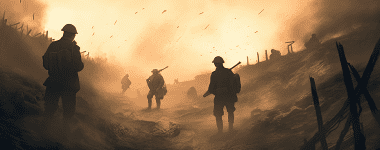
Germany began WWI on August 1, 1914 – which fell out on Tisha B’av.
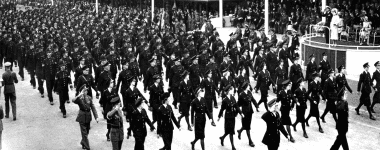
The Final Solution (ideas for killing Jews during WWII) was formulated two days before Tisha B’av (the 7th of Av).
In short, history demonstrates that this is a most pain-laden time for our people. Why is this so? Way back, after our people had been forged into Hashem’s nation, and when we were to go from the revelation at Sinai directly to the Promised Land, we transgressed.
We cried for no reason in the desert when the spies terrified us into not wanting to enter the Promised Land. At that time, Hashem said, “This day when you cried for no valid reason, which is the ninth of Av, will be slated as the day for you to cry when you will have good cause to cry.” Punishments are often slated for our nation during this period.
Megillas Eichah, the Book of Lamentations, is read in shul and at home. The scroll tells of the temple’s destruction, the Jewish people, and the Holy Land.
We adhere to all the various laws of mourning for at least the first half of the day of Tisha B’av (until Chatzos, which is the midway point of the day, at around 1 p.m.).
Like someone sitting Shiva, we do not:
- Study Torah (except for the parts of the Torah that are associated with the Beis Hamikdash’s destruction).
- We do not sit on chairs or couches.
- Work or do anything leisurely.
- We do not shower or bathe.
- Men do not put on Tefillin.
Unlike someone sitting Shiva, as soon as Chatzos has passed, right after the midway point of Tisha B’Av day, there is a strange custom. We begin to clean our homes. We demonstrate that even though we are going through a period of mourning, we still anticipate the arrival of Moshiach. That out of the darkest places, we know with all our hearts that we will be everlasting joy one day.
From here on, we refer to this month as Menachem Av – a comforting month. We pray that all bad happenings will be transformed into good ones in the coming times of Moshiach. May we all be comforted speedily in our time!
Reasons For Fasting On Tishah B’Av
On this day, five tragedies befell our nation.
During the time of Moshe Rabeinu, Jews in the desert accepted the slanderous report of the 10 Spies, and a decree was issued forbidding them from entering Eretz Yisrael.
The Babylonians destroyed the first Beis Hamikdash.
The Babylonians destroyed the first Beis Hamikdash.
The Romans captured the city of Beitar and slaughtered tens of thousands of Jews
Turnus Rufus – an evil man – plowed over the site of the Beis Hamikdash.

Laws Of Tishah B’Av
On Tisha B’Av, all prohibitions associated with the Three Weeks and the Nine Days are in full force. Well-known customs unique to this day include the prohibition of studying the Torah, sitting on a chair (until midday), working, and greeting others.
Five prohibitions govern this day. On Tisha B’Av, adults do not:

Eat or drink.

Wash or Bathe.

Anoint themselves.

Wear leather shoes.

Engage in marital relations.

Yearning For the Beis Hamikdash
The Talmud states that Hashem cries privately over the destruction of the Beis Hamikdash. The Maharal writes that the secret hideaway where Hashem cries is situated within the soul of every Jew. For the soul emanates from the Creator and is hidden deep inside man.
A Jew’s soul cries incessantly over the Destruction of the Beis Hamikdash. It weeps without letup for all that has been lost. But why is it not detected? The Chassidic master, Reb Bunim of P’shis’cha, offered a parable. Once, a king was amassing fantastic treasures, which he hid in a secret hideaway deep under his palace. One day a great fire broke out in the capital. It spread quickly, burning down the palace and the hideaway that contained the treasures. A great wave of mourning swept over the nation, and they cried for all that had been lost. But the king cried most bitterly of all. Only he knew about the fantastic treasures that had been destroyed.
Like the compatriots, we cry for the Beis Hamikdash. Our souls, however, cry most of all. We exhibit a more explicit recognition in the recesses of our soul beyond what ordinary men can detect. And while it may not be easily detectable, on Tisha B’av, that cry rises and expresses itself tangibly, even for ordinary human beings.
The Beis Hamikdash unified the Jewish nation. Like the heart of man, it pumped the vitality of the people coursing through their veins, offering a connection to spirituality far beyond our imagination. While we will forever endure, we exist in a crippled state. Today, Jerusalem is a sprawling city, home to tens of thousands of Jews, Torah institutions, and prayer. But its most vital organ is missing.
Yet, although we cry for what we once had, we weep mainly for the future. The following story illustrates why.
The great Rama, Rabbi Moshe Isserles, writes that the Greek philosopher Plato accompanied Nebuchadnezzar when he came to destroy the First Beis Hamikdash. After the destruction, Plato found the Navi Yermiyahu weeping bitterly near the Beis Hamikdash ruins. Plato asked Yermiyahu two questions. First, how could such an eminent man cry so bitterly over sticks and stone, and besides, the Beis Hamikdash is already burned down? What benefit is there to tears?
At this point, Yermiyahu asked Plato about some of his most vexing philosophical questions. The great philosopher listed some thorny problems, which Yermiyahu answered with ease. Shocked, Plato exclaimed, “I cannot imagine that a mere mortal can be so wise!”
Yermiyahu then said that all his knowledge emanated from those “sticks and stones,” which explained why Yermiyahu was crying so bitterly. However, Yermiyahu said he could not answer why tears are beneficial after the fact. Plato would not understand.
Some suggest that Yermiyahu wouldn’t answer why he still cried because Plato could never understand. Our tears aren’t just for the past; we weep for the future. While the heavenly gates were sealed off since the destruction, the gate of tears remains. Every tear ascends heavenward, is collected, and contributes toward reconstructing the final and everlasting Beis Hamikdash. This is a belief that rational Plato could never comprehend, as it defied logic. As such, Yermiyahu left the question unanswered.
TISHA B’AV IN BELZ
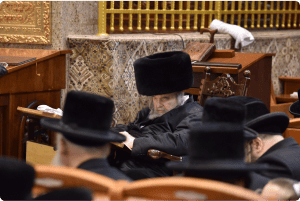
Mourning the Destruction
After sunset, on the eve of Tisha B’Av, thousands of Chassidim gather in the Big Belz Shul in Yerushalayim to mourn the destruction of the Beis Hamikdash. It is customary to dim the lights and sit on the floor during the Eichah reading.
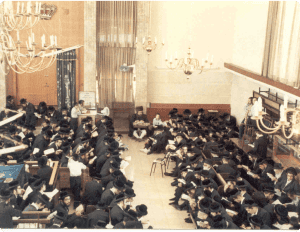
Praying for the Redemption
At Shachris on Tisha B’Av morning, we daven without wearing a Tallis or Tefilin. The special Tisha B’Av Kinos are recited until midday.
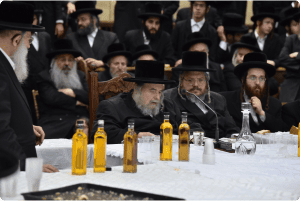
Awaiting the Geulah
When Tisha B’Av concludes, the Belzer Rebbe shlita leads a L’chaim with heartfelt singing. Songs of hope and redemption uplift the hearts and souls of many who yearn for the new spark of Redemption that will hopefully arrive speedily in our days.
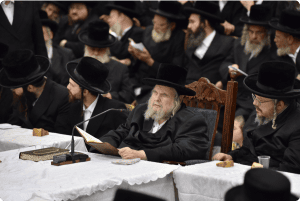
Words of Hope
At the Lechaim, the Belzer Rebbe shlita speaks about the Geula, inspiring those present with hope and joy.
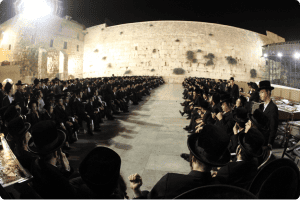
By The Kosel
Later that same night, the Yeshiva students gather at the Kosel to sing songs of hope and inspiration.

INSPIRE YOUR INBOX.
Enjoy a weekly dose of Chassidic insights, highlights and happenings at Belz.

